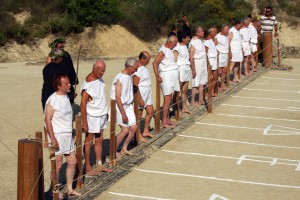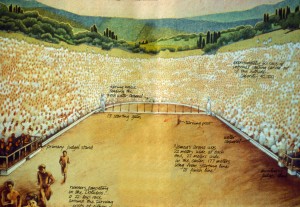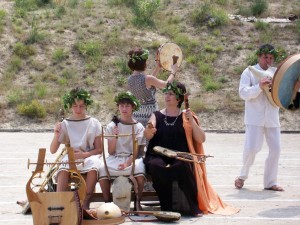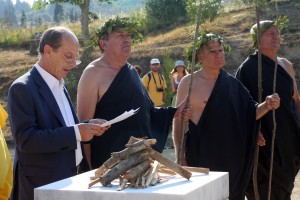We stumbled upon the existence of the Revival of the Nemean Games through a throw-away comment from an archaeologist, Heinrich Hall, who has lived in Athens for 10 years. Having featured the Peloponnese since 1974 – in fact, that is where Sunvil’s programme to Greece originated – I was unaware that there had been such extensive excavation of the stadium at Nemea or that, every four years, there was a re-enactment of the original pan-Hellenic Games dating back over 2,000 years.
The setting of the stadium and the Temple of Zeus at Nemea is spectacular. As our long-featured resort of Tolon is but a half-hour away, a few of us decided that we had to come and watch the ceremonies and the Games. Little did I realise that my wife had actually entered me – and herself – for the 90m sprint. Such was the general enthusiasm that Chris Wright, Sunvil’s Operations Director and Managing Director of GIC The Villa Collection, entered both the sprint and the 7.5 km endurance race, In the Footsteps of Herakles.
It wasn’t until the excavation of the tunnel between the locker room and the stadium took place, starting in 1974, that archaeologists realised that the Greeks as well as the Romans were able to build arches – a sophisticated building innovation back in those days. It revolutionised archaeological thinking about what the Greeks were capable of in building terms – and this was discovered less than 40 years ago.
The opening ceremony of the 5th Modern Nemean Games 2012 – the fore-runner of the present-day Olympics – took place on Friday 22nd June, within the ruins of the Temple of Zeus. Grecian-style-clad maidens in cream full-length dresses and fully armoured Spartan soldiers, set against a backdrop of the ruins and the green Nemean countryside, created an unforgettable spectacle. The Games began the following morning but are, these days, restricted solely to running – wrestling and chariot races, thank goodness, were not on the agenda in June 2012.
The participants emerge from the 2,300-year-old tunnel into the sunlight of the excavated stadium and are announced individually after a herald sounds a salute before drawing lots from a Spartan helmet for their lane position. The older men ran first, from 8 am and before the heat of the day. I was in the fourth race. Standing in the original stone starting blocks and waiting for the signal to run – barefoot, and clad in a white tunic – the adrenaline really began to flow. I started well, to the cheers of my wife and sister, but unfortunately, being unfit and rather overweight, my legs gave way after about 40m and I executed a dramatic fall. I rose, tried again and fell again; I finally came in second to last, coated with yellow dust from the earth floor of the stadium.
But I’ll never forget the day and the sheer excitement of the whole event. What a wonderful way to celebrate the excavation of this superb site. The Peloponnese is where Greek civilisation began, with Mycenae, Epidavros, Corinth, Tyrins, Assini and Nemea all within a very easy drive of the former modern Greek capital of Nafplion and the welcoming fishing village of Tolon, both on the enticing coastline of the eastern Peloponnese and but a couple of easy hours’ drive from Athens.
We all forget how beautiful Greece is and it was very important that we should have made this pilgrimage because we were reminded again exactly why we feature this most wonderful of all Mediterranean destinations.
Would I run again in four years’ time at the 2016 Nemean Games? Most definitely – and then, being that little bit older, I may get to run earlier in the morning and might well finish the 90m without falling over. It’s in my diary already for June 2016, and I hope that many more will join us from the United Kingdom to meet with the other 100 or so nationalities whose flags fluttered at the end of the stadium in celebration of a brilliant event that brought us all together, just as the Ancient Games did, encouraging people to stop fighting for one week every year as they rotated from Olympia to Delphi and from Isthmia to Nemea. The Nemean Games are every bit as relevant today, in the 21st century AD, as they were nearly 3,000 years BC.
There is no entry fee for the Nemean Games. It’s not commercialised in any way. You sign up on line, you’re allotted your race time, you’re given a tunic to wear, you’re announced and you race barefoot. Winners receive a ribbon and a palm frond. Everyone is given a printed programme and a history of the Nemean Games, with interesting information about the excavation, carried out by Berkeley University, California. All race participants are given a tee-shirt as a memento of the day, and are invited by the villagers of Nemea to join a feast in the village square after the races. Wine is provided by the Nemean wineries of the valley, as it was in the days of the original Nemean Games over 2,000 years ago. There is something hugely satisfying about the simplicity of it all – a giant sports day in which participants from Kazakhstan mingled happily with those from Peru, and Americans with people from Papua New Guinea, and a hundred or more other nationalities besides. Young and old, local and foreign, all enjoying the same event – all running barefoot on the earth of Nemea, as their Greek forebears had done in antiquity. This is perhaps what the Olympic Games should again seek to become – less a show of wealth and national might and more an opportunity to compete on a level playing field with other nationalities in friendship and understanding.
Noel Josephides








